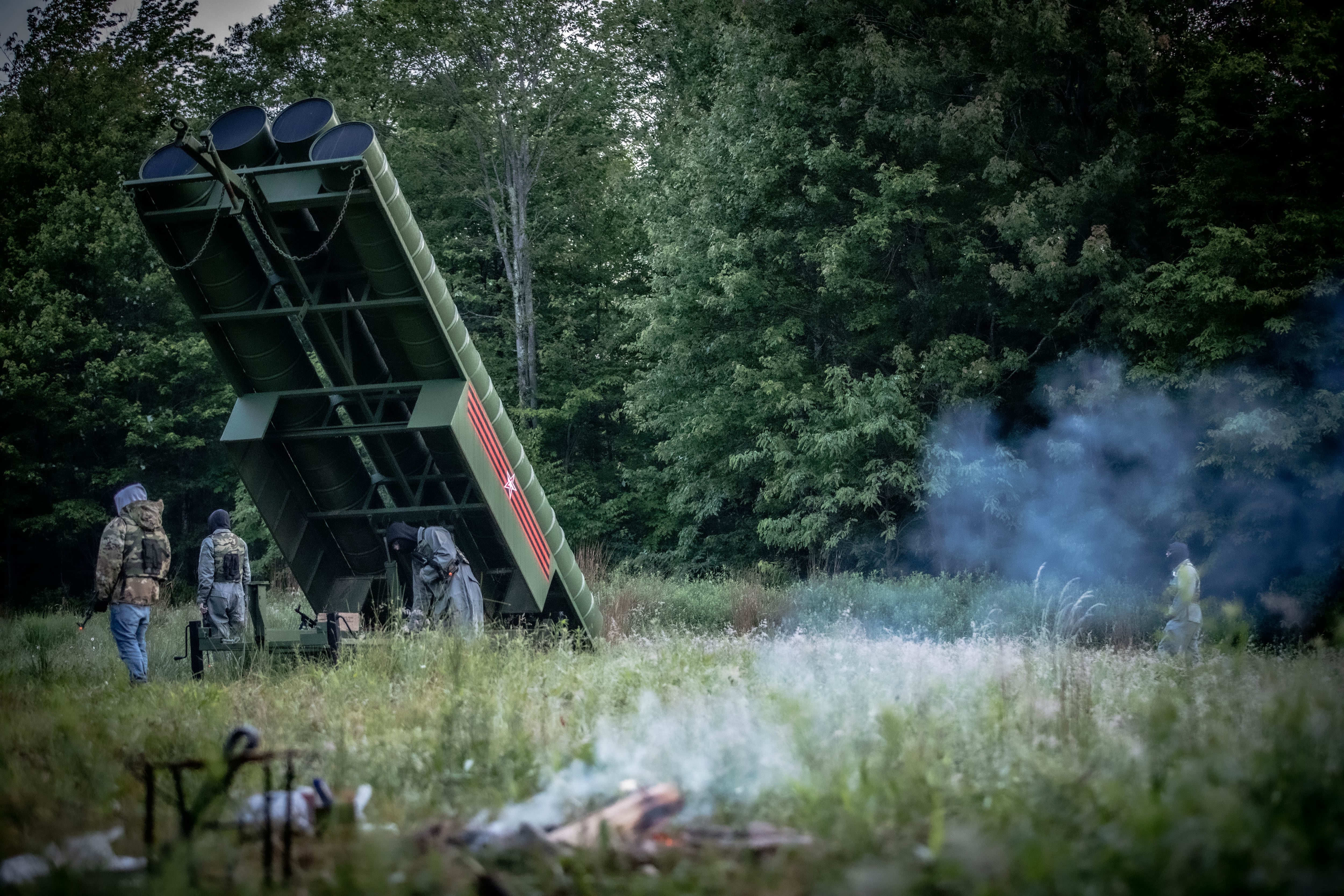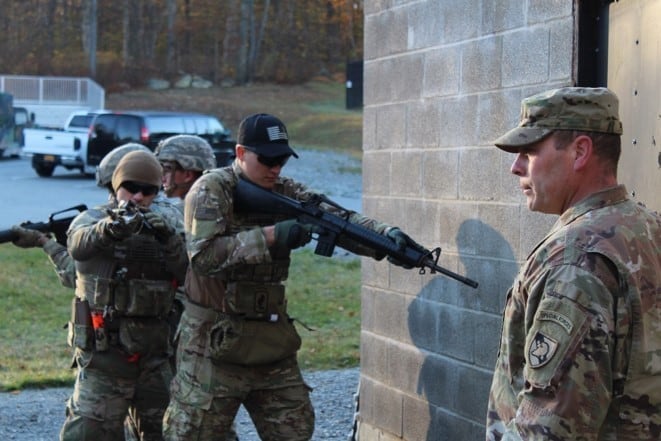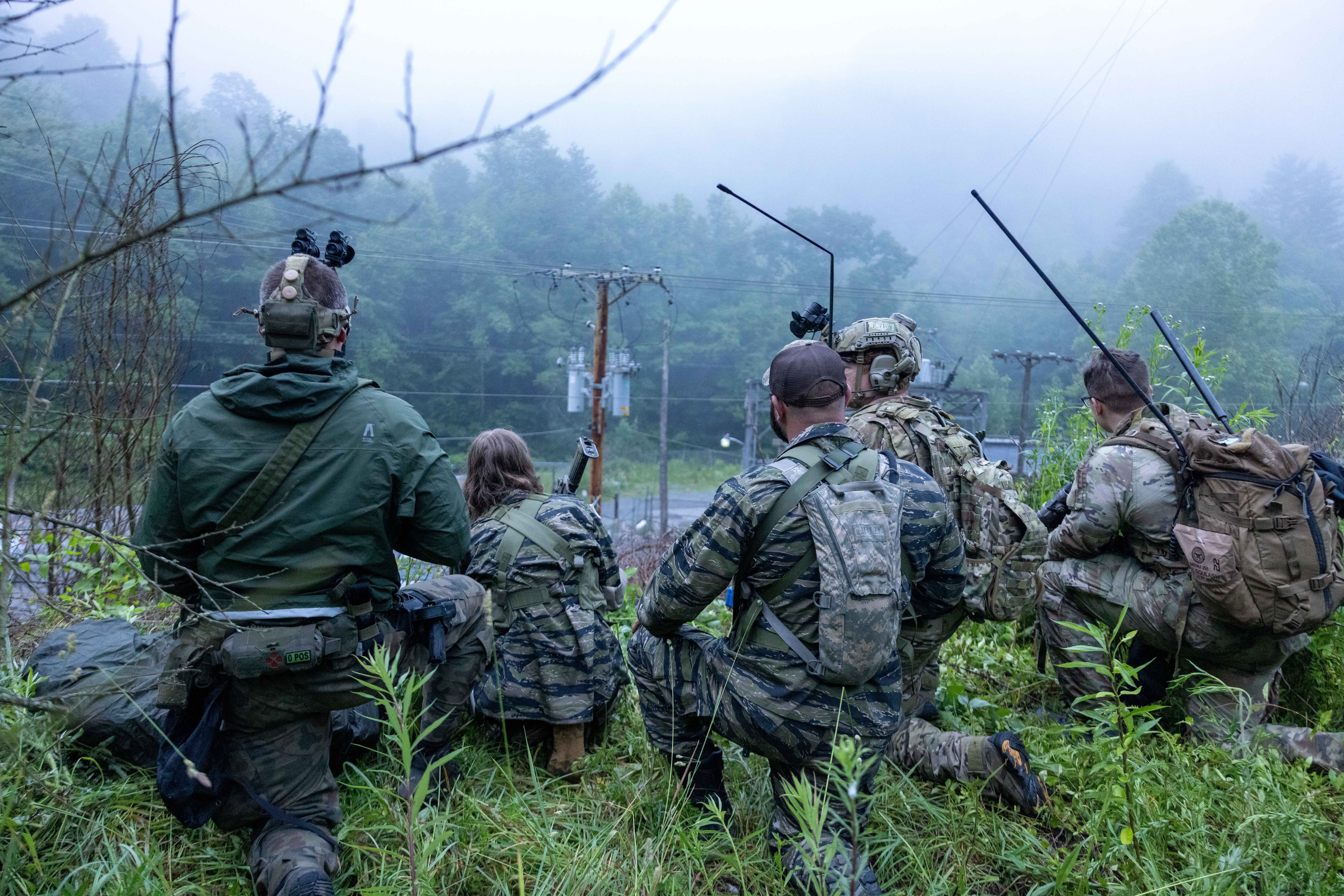They didn’t arrive under the cover of darkness, parachuting in from thousands of feet above, nor did they slip into a remote beach cove on a rubber boat.
The teams of special operations soldiers and Marines stood in line, handed over their passports and waited respectfully while airport security patted them down and scrutinized their government forms.
The more than a dozen men didn’t wear uniforms, but their civilian clothes, military haircuts and posture were a giveaway.
And that was all part of the plan.
These special operators — Green Berets from 5th Battalion, 19th Special Forces Group; an Army psychological operations unit; and the Marine Corps Reserve 4th Civil Affairs Group — weren’t looking for a cloak-and-dagger operation. The members of this task force came to meet with local officials in Morgantown, West Virginia, otherwise known in this fictional military exercise scenario as the proud nation of Kanawhaton.
As the days of the Army National Guard-led Ridge Runner exercise unfolded and an aggressive neighboring state mounted simulated attacks, the team continued talking with local leaders about building goodwill through sanitation and education projects, coordinating with teams in the field, and spotting enemy soldiers from the fictional country of Watogan as they breached the Kanawhaton border.
The scenario that played out in the West Virginia mountains in June may have been fake, but it was similar to work that Army Special Forces have performed for years across the globe, nowhere more pronounced than in Ukraine, especially since the 2014 Russian annexation of Crimea and Russia’s full-scale invasion in 2022.
As the U.S. military shifts its sights to new ground vehicles, missiles, robots and artificial intelligence that it hopes will modernize the force for the possible conflict between nations with standing militaries of their own, at least one Cold War lesson resonates: Preparing for the big fight is crucial, but soldiers are more likely to face an enemy’s bullets in smaller conflicts that don’t include peer-on-peer fighting, yet still influence the power and position of those peer nations.
Those conflicts may start small but can metastasize over time, as was the case in Vietnam and Afghanistan — and even Kanawhaton.
Both scenarios fall in the shadow of U.S. military competition with Russia, China, North Korea, Iran and other adversaries, but also lie directly in the crosshairs of an age-old effort: irregular warfare.
Though irregular warfare can refer to smaller-scale conflict, its use in military competition is to gain political influence by providing training, expertise, and both military and nonmilitary aid to partner and allied forces. On the ground, that has historically meant small teams of special operators meeting, training and living with partner forces for extended periods of time.
Door-kicking operators will always be needed. But people skills, an understanding of language and culture, and relating to partner forces at an individual level may be in higher demand.
But this won’t happen overnight.
Special operations experts do tout their system, which involves training teams focused on psychological operations and civil affairs as well as operators before sending them repeatedly to the same region for years. Though time-consuming and founded on developing hard-earned experience, members of the special operations community point to this approach as a key factor to their success in areas such as Colombia, which saw its share of violence but never erupted into a transregional conflict after decades of special operations forces’ involvement.
Irregular warfare experts and research suggest these kinds of capacity-building approaches are critical for U.S. forces to have both an understanding an understanding of their allies in the area if a conflict erupts.
But strains on military recruiting, especially in the Army, threaten cuts to personnel in special operations and elsewhere. Army Secretary Christine Wormuth’s staff declined to comment on personnel planning matters when asked by Army Times.
“Due to the recruiting crisis, the Army’s total end strength is decreasing so they are looking across the enterprise for places to cut,” said a congressional aide to Republican Sen. Ted Budd of North Carolina, whose state is home to U.S. Army Special Operations Command and U.S. Marine Forces Special Operations Command. “They’ve opted to make cuts to SOF [special operations forces] to maintain conventional capabilities that not everyone is convinced will have the same impact in either competition or potential conflict.”
Advocates for the special operations community say this is the time to leverage experience in irregular warfare to the U.S. military’s advantage. And the recipe for success requires two non-negotiable ingredients: time and people.
“Conventional units are just not a natural fit,” said retired Air Force Lt. Gen. Thomas Trask, former vice commander of U.S. Special Operations Command.
When did this shift start?
The 2018 National Defense Strategy first spelled out the official military move to great power competition — the “great power” part meaning essentially industrialized nations with large, standing militaries such as the United States, Russia and China; and “competition” representing what occurs before bullets start flying — usually involving nonconventional military and intelligence operations. That has mostly meant positioning troops and equipment in various strategic areas, partnering with nations against advanced forces like those of Russia and China, and training those partners to counter adversaries both before and during a potential conflict.
Irregular warfare was not mentioned by name in that document. But by 2020, an annex dedicated to irregular warfare emerged in the National Security Strategy.
The same document admonished readers to avoid temperamental funding and focus on the effort.
“We must not — and will not — repeat the ‘boom and bust’ cycle that has left the United States underprepared for irregular warfare in both great power competition and conflict,” the document stated.
The Army’s version of next year’s budget seeks to cut 10% to 20% of the military personnel within the service’s special operations force due to overall recruiting shortfalls and competing modernization priorities.
Numbers fluctuate, but Army Special Operations Command includes roughly 34,000 personnel. They fall under U.S. Special Operations Command, which oversees an estimated 53,000 personnel, according to official figures.
The Army’s special operations force makes up more than half of all of U.S. Special Operations Command, and the service carries the largest contingent of special operations personnel among all the military branches.
Wormuth is expected to present her proposed recommendations for reductions to the service to Congress during the budget process.
The overall special ops community grew tremendously over the course of the post-9/11 era, adding personnel, missions and leadership at levels that U.S. Special Operations Command had not seen in its 36-year history.
While much of that work did include training partner forces, most of the missions focused on counterterrorism.
As the Defense Department shifted its focus to China and Russia, U.S. Special Operations Command found itself in a transition period, emphasizing a need for more cyber and electronic warfare capabilities while also refreshing and revitalizing missions that were more common during the Cold War.

The potential cuts, still not yet clearly defined by the Army, have triggered an outcry from the special operations community. Indeed, a sustained focus on irregular warfare has always been a challenge, experts noted.
“America’s way of warfare is vastly more aligned with conventional warfare than with irregular warfare,” said Jonathan Schroden, an expert in irregular warfare at the CNA think tank.
But that focus on big weapons systems and large formations doesn’t address irregular warfare threats, those that have plagued U.S. forces since at least Vietnam and dragged on through the decades-long war in Afghanistan.
Three big areas unique to Army special operations forces — operational detachment alpha teams, psychological and civil affairs — are not replicated in other parts of the service. If trimmed, that’s less capability in those areas for future special forces missions, leading to tough choices about where to deploy the remaining teams and choosing which regions go uncovered.
Without those assets, Schroden said, the military risks not having “access and placement” for the conventional forces in areas where Army special forces traditionally deployed and built long-standing relationships.
Trask, who served as the vice chief of U.S. Special Operations Command from 2014 to 2017, told Army Times that despite its success, the special operations community is always under a funding microscope.
“There is always a target on SOCOM,” Trask said.
In current House and Senate versions of the budget, congressional committees have now included language that requires more detailed explanations of budget requests, and one version includes a prohibition on cutting Army special operations personnel in the current budget.
“We expect the [Defense] Department to ‘show us their math’ in both a written report and briefings,” the congressional aide for Budd told Army Times. “How do the proposed cuts align with the National Defense Strategy, Joint Concept for Competing, increasing combatant command demand for SOF, and the already stressed SOF enterprise given their roles in counterterrorism, crisis response and competition?”
Amid this uncertainty, the Army is trying to figure out where its special forces fit in a conventional war. And the special operations forces community is trying to convince the powers that be that these unique personnel have a role in that fight — a role only they can fill.
With recruiting continuing to struggle, the fight over personnel cuts is likely to move to next year’s budget, experts said.
“The distinction here really falls into a definitional debate. Do you believe that [U.S. Army Special Operations Command] is more part of the Army or more part of the SOF enterprise overseen by SOCOM?” Schroden said. “The Army is arguing at this point that it’s more of the former.”
Irregular warfare is different
The 2020 irregular warfare annex spells out that sustaining irregular warfare competencies is not only the job of special operations but also a necessity for the conventional force.
Some of that is seen in the Army’s fielding of its security force assistance brigades, six of which were established between 2017 and 2022 to focus on their respective geographical regions. The brigades often operate in small teams, training partner forces in conventional military skills.
But Trask and others told Army Times that while those units are helpful on the conventional side, the irregular warfare approach includes the unique skills of special operations forces.
For example, combined teams during the Ridge Runner exercise in West Virginia saw a Marine Reserves civil affairs team working with a local mayor on water purification projects while Green Berets in the same team simultaneously helped identify emerging battlefield targets, such as enemy drones and short-range missile launchers deployed in the host nation’s territory.
“The Army seems to imagine that they’re going to do this irregular warfare with units other than SOF and that they’re trying to justify their own force structure based on that,” Trask said.
That’s in part because teams within the Green Berets may return multiple times over many years to the same region, working with the same local counterparts over the course of a career. That builds competency, clear communication and trust.
And it takes time.
If too many individual positions are cut in the special operations force, some areas will not be covered. And the damage may not be seen for years.

Special operations teams are already spread thin across the various combatant commands and are always in high demand for a variety of missions.
Though special operations forces, more so perhaps than any other portion of the military, has boots on the ground in nearly every region on the planet, China and the Pacific theater remain the main focus for nearly every facet of the U.S. military. That’s true both for the conventional fight — think ships, planes, missiles and troops — and the irregular fight, which leans on small teams training other small teams in faraway hills, jungles and city centers.
“Now you’re having to make sure ... you’ve created those relationships in the right places that are going to be the places where you’re going to want to counter Chinese influence over the next 10 to 20 years,” Trask said.
If the U.S. military guesses right — that long-term commitment could prevent a war. If leaders are wrong then the United States may not have any capabilities — or friends — in the neighborhood when the Chinese military comes calling.
A possible path forward
It’s unclear what’s likely to be cut from the Army’s special operations community. For now, the service is undergoing its so-called total Army analysis process, looking to decipher what kinds of forces it needs to meet the current and future threats by manning its combat divisions and brigades. That process will affect more than just special operations.
Back at the Ridge Runnder exercise, events unfolded that echoed Russia’s ongoing war against Ukraine. A smaller nation faced incursions by a neighboring country’s forces into its territory while cyberattacks and influence operations sought to overthrow political leadership.
But a combination of aid for local infrastructure needs and pairing U.S. teams with host nation units helped beat back the small-scale invasion.
The wars in Iraq and Afghanistan incorporated the use of Guard and Reserve special operators more than at any previous point, said Doug Livermore, communications director for the Irregular Warfare Initiative, partly sponsored by the Modern War Institute at the U.S. Military Academy. Livermore also serves an Army reservist and is deputy commander of an Army special ops advisory group.
“It has certainly been a shift,” Livermore said about the growing capabilities of special operations forces in the Guard and Reserve. “I would call it an evolution rather than a revolution.”
While the Guard and Reserve could not replace what their active duty counterparts do, they could supplement the work.
One contribution the Guard could make is to provide an enduring presence in various regions, Livermore said. He pointed to the decades-long Army National Guard state partnership program, which pairs each of the states with a foreign partner or ally.
He likened the work of active duty special operators, tasked under various geographic combatant commands, to a “sprint” — meeting current threats as they arise. But a special operations Guard unit can return again and again to the same place.
“Over time an active duty [special forces] group touches the same group. Now, we’re really taking this long view, particularly as we counter Russia and China. These are going to be generational approaches that require not sprinting ... but incorporating the Guard into that, taking a longer view,” Livermore said.
Todd South has written about crime, courts, government and the military for multiple publications since 2004 and was named a 2014 Pulitzer finalist for a co-written project on witness intimidation. Todd is a Marine veteran of the Iraq War.





